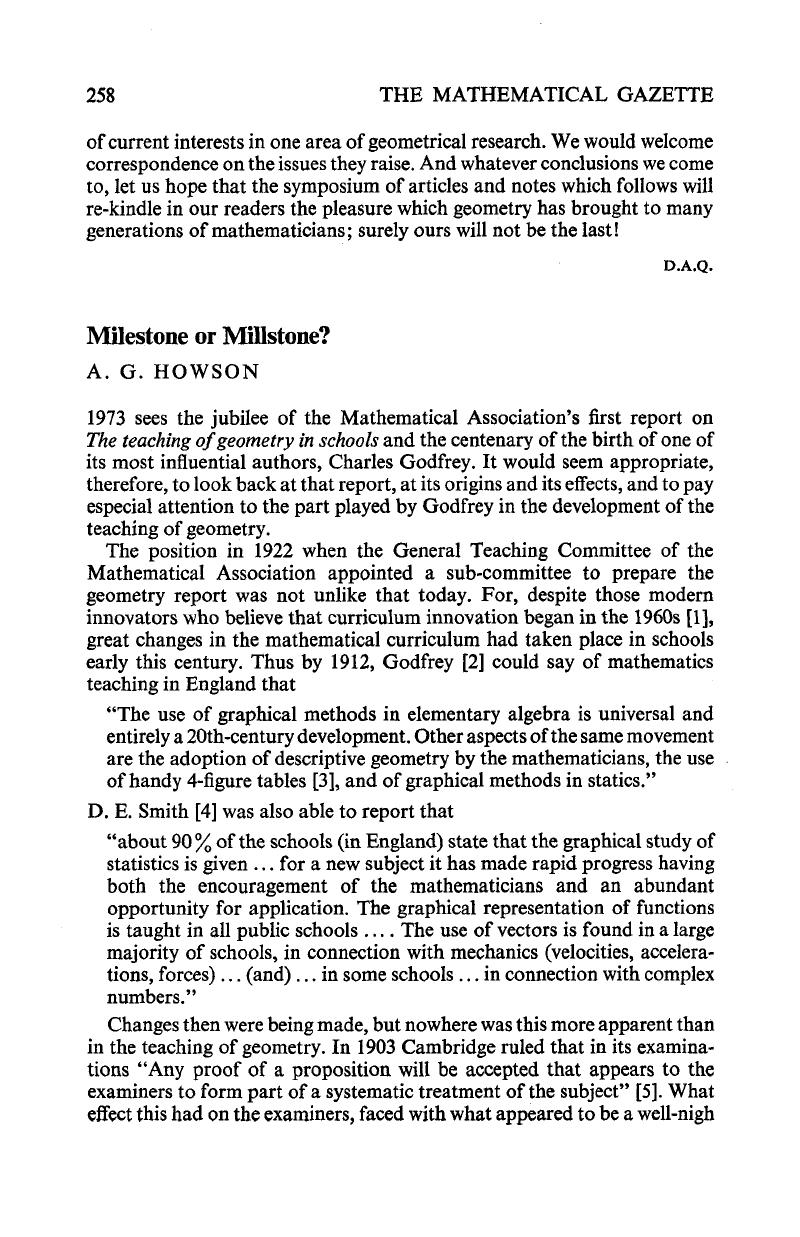Article contents
Milestone or Millstone?
Published online by Cambridge University Press: 03 November 2016
Abstract

- Type
- Other
- Information
- Copyright
- Copyright © Mathematical Association 1973
References
Notes and References
1. For example: “Nearly twenty years ago, as a young teacher, came to the conclusion that methods of teaching mathematics were out of date. Little had been changed for hundreds of years.” Pioneers of new maths–1, Mod maths and science (British Thornton newsletter) No. 1 (1970).
2. Godfrey, C., Methods of intuition and experiment in secondary schools, Proc. 5th I.C.M. (1912), Vol. II, 641. Cambridge University Press (1913).Google Scholar
3. Previously schools had used 7-figure tables, and a questionnaire circulated in 1911 to 551 secondary schools showed that 7-figure tables were still used in the upper classes of about 15% of the schools. Interesting comments on the change-over from 7- to 4-figure tables are contained in Siddons, A. W., Progress, Mathl Gaz. XX (1936).Google Scholar
4. Smith, D. E., Intuition and experiment in mathematical teaching in the secondary schools, Proc. 5th I.C.M. (1912), Vol. II, 622. Cambridge University Press (1913).Google Scholar
5. The moves which led to this decision are amusingly described by Siddons in the article referred to in [3] above.
6. Godfrey, C., The teaching of mathematics in English public schools for boys, Proc. 4th I.C.M. (1908), Vol. III. Lincei (Rome, 1909)Google Scholar.
7. Professor Perry, an engineer and a former master at Clifton College, inaugurated a discussion at the 1901 meeting of the British Association in Glasgow by reading a paper attacking the mathematical teaching of the period. He maintained that the study of mathematics began because it was useful, continues because it is useful and was valuable because of its usefulness. For these reasons it should be taught so as to appear useful and pupils should learn something of its applications. A summary of his main points is to be found in Teaching mathematics in secondary schools, H.M.S.O. (1958), and some indication of his effect overseas in A history of mathematical education in the United States and Canada, 32nd yearbook of the N.C.T.M. (1970).
Oliver Heaviside dismissed as “fudge and fiddlesticks” “the prevalent idea (that) you must understand the reason why first, before you proceed to practice”. Mathematical understanding, he claimed, came with practice—and could not precede it ( cf.Whitney, H., Are we off the track in teaching mathematical concepts? in Developments in mathematical education, Cambridge, 1973)Google Scholar.
8. Nature, Lond. 16 January 1902. This letter led to the establishment in 1902 of the Teaching Committee of the Mathematical Association.
9. Mathl Gaz. II (1903), reprinted LV, 239-240 (No. 392, March 1971).
10. Godfrey, C., Geometry teaching: the next step, Mathl Gaz. X, 20–24 (1920)CrossRefGoogle Scholar.
11. Carson, G. St. L., The educational value of geometry, in Teaching of mathematics in the United Kingdom, Vol. I. H.M.S.O. (1912)Google Scholar.
12. Compare the emphasis placed on Haeckel’s Law of Recapitulation by Rene Thorn in his two papers ‘Modern’ mathematics: an educational and philosophical error?, Am. Scient. 59 (6), 695-699 (1971) and Modern mathematics: does it exist?, in Developments in mathematical education (Cambridge, 1973).
13. Godfrey, C., The Board of Education circular on the teaching of geometry, MathlGaz. V, 195–200(1910)Google Scholar.
14. Wagstaff, C. J. L., Should we continue to teach geometry?, Mathl Gaz. IX, 38–40 (1917)CrossRefGoogle Scholar.
15. Dobbs, W. J., Mathematics in secondary schools, Mathl Gaz. IX, 40–42 (1917)CrossRefGoogle Scholar.
16. Compare the findings of the Jeflery Committee almost thirty years later (see, for example, Teaching mathematics in secondary schools, H.M.S.O. 1958).
17. Dobbs, W. J., The teaching of geometry and trigonometry, Mathl Gaz. V, 139–146, 167–170 (1913)CrossRefGoogle Scholar.
18. Dobbs, W. J., A school course ingeometry. Longmans (1913)Google Scholar.
19. Freudenthal, H., What groups mean in mathematics and what they should mean in mathematical education, in Developments in mathematical education (Cambridge, 1973)Google Scholar.
20. Mathl Gaz. XII (1924). Baker’s criticism is reprinted in Mathl Gaz. LV, 146-152 (No. 392, March 1971).
21. The teaching of geometry in schools (4th edition), p. 1. Bell (1944).
22. Mathl Gaz. X, 24 (1920). Account of discussion following the presentation of Godfrey’s paper Geometry teaching: the next step (see [10]).
23. Quadling, D. A., The mathematics of SMP, in SMP: the first ten years. Cambridge University Press (1972)Google Scholar.
24. Mathl Gaz. XII, 137-138(1924). An account of Godfrey’s work in other branches of mathematics is given in A. G. Howson, Charles Godfrey and the reform of mathematical education, Educ. Stud. Math, (to appear).
- 1
- Cited by


